Nursing Care Intervention for Emphysema: A Case Study
VerifiedAdded on 2023/06/07
|7
|2049
|273
AI Summary
This case study discusses the nursing assessment, pathophysiology, nursing interventions, and the role of physiotherapist in the management of emphysema. It also highlights the abnormal findings and the possible nursing care interventions for the patient. The report concludes with the importance of diagnosing and providing the best quality medical treatment to the patient.
Contribute Materials
Your contribution can guide someone’s learning journey. Share your
documents today.
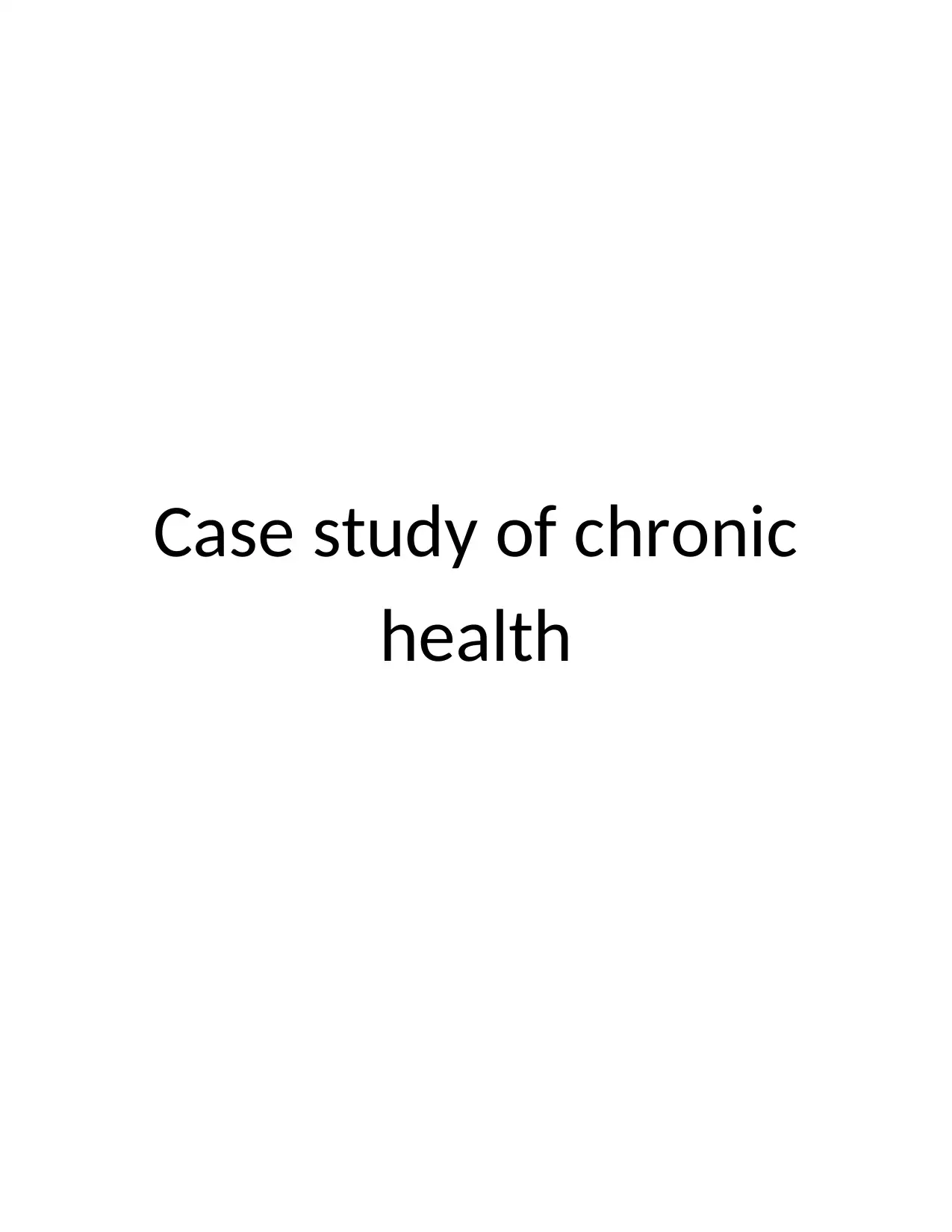
Case study of chronic
health
health
Secure Best Marks with AI Grader
Need help grading? Try our AI Grader for instant feedback on your assignments.
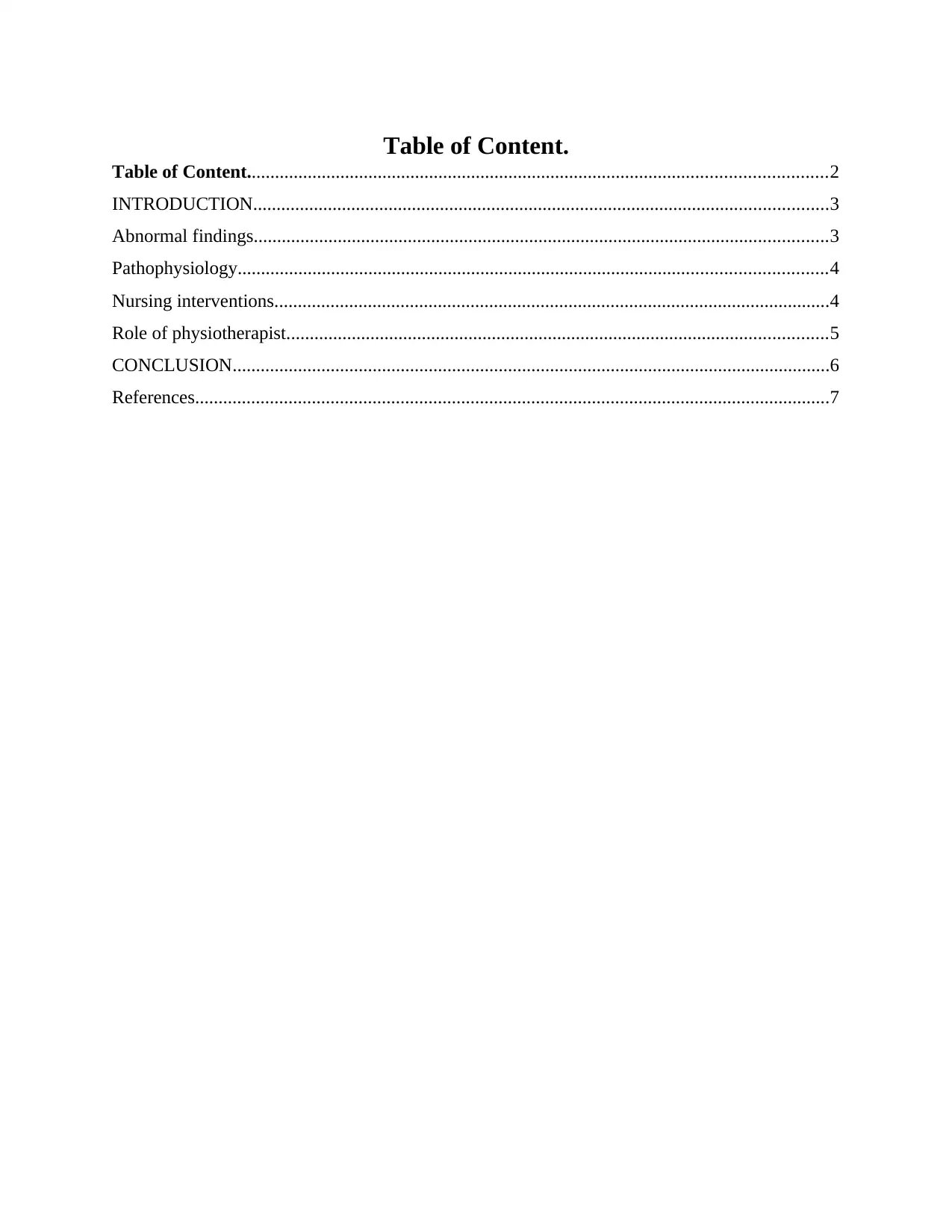
Table of Content.
Table of Content............................................................................................................................2
INTRODUCTION...........................................................................................................................3
Abnormal findings...........................................................................................................................3
Pathophysiology..............................................................................................................................4
Nursing interventions.......................................................................................................................4
Role of physiotherapist....................................................................................................................5
CONCLUSION................................................................................................................................6
References........................................................................................................................................7
Table of Content............................................................................................................................2
INTRODUCTION...........................................................................................................................3
Abnormal findings...........................................................................................................................3
Pathophysiology..............................................................................................................................4
Nursing interventions.......................................................................................................................4
Role of physiotherapist....................................................................................................................5
CONCLUSION................................................................................................................................6
References........................................................................................................................................7
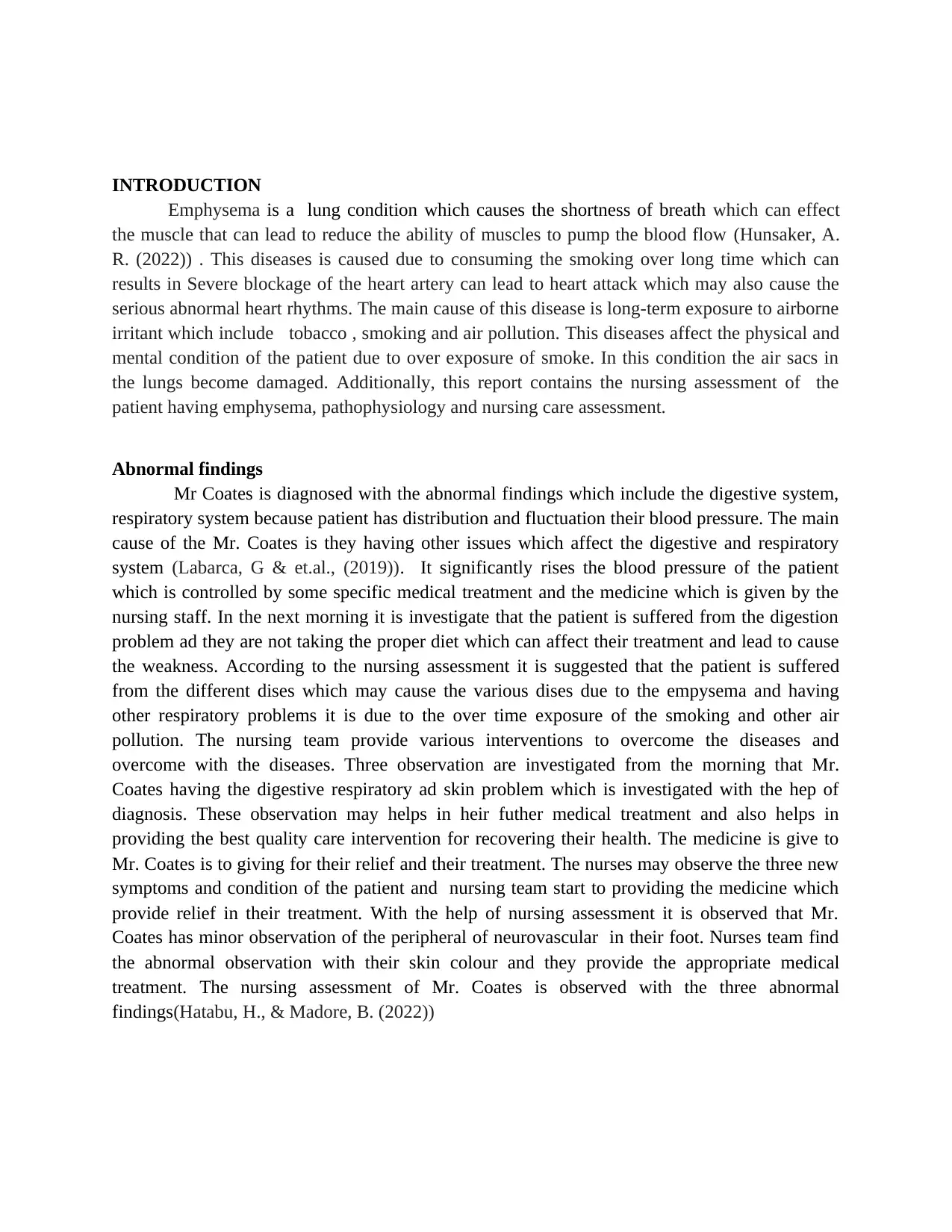
INTRODUCTION
Emphysema is a lung condition which causes the shortness of breath which can effect
the muscle that can lead to reduce the ability of muscles to pump the blood flow (Hunsaker, A.
R. (2022)) . This diseases is caused due to consuming the smoking over long time which can
results in Severe blockage of the heart artery can lead to heart attack which may also cause the
serious abnormal heart rhythms. The main cause of this disease is long-term exposure to airborne
irritant which include tobacco , smoking and air pollution. This diseases affect the physical and
mental condition of the patient due to over exposure of smoke. In this condition the air sacs in
the lungs become damaged. Additionally, this report contains the nursing assessment of the
patient having emphysema, pathophysiology and nursing care assessment.
Abnormal findings
Mr Coates is diagnosed with the abnormal findings which include the digestive system,
respiratory system because patient has distribution and fluctuation their blood pressure. The main
cause of the Mr. Coates is they having other issues which affect the digestive and respiratory
system (Labarca, G & et.al., (2019)). It significantly rises the blood pressure of the patient
which is controlled by some specific medical treatment and the medicine which is given by the
nursing staff. In the next morning it is investigate that the patient is suffered from the digestion
problem ad they are not taking the proper diet which can affect their treatment and lead to cause
the weakness. According to the nursing assessment it is suggested that the patient is suffered
from the different dises which may cause the various dises due to the empysema and having
other respiratory problems it is due to the over time exposure of the smoking and other air
pollution. The nursing team provide various interventions to overcome the diseases and
overcome with the diseases. Three observation are investigated from the morning that Mr.
Coates having the digestive respiratory ad skin problem which is investigated with the hep of
diagnosis. These observation may helps in heir futher medical treatment and also helps in
providing the best quality care intervention for recovering their health. The medicine is give to
Mr. Coates is to giving for their relief and their treatment. The nurses may observe the three new
symptoms and condition of the patient and nursing team start to providing the medicine which
provide relief in their treatment. With the help of nursing assessment it is observed that Mr.
Coates has minor observation of the peripheral of neurovascular in their foot. Nurses team find
the abnormal observation with their skin colour and they provide the appropriate medical
treatment. The nursing assessment of Mr. Coates is observed with the three abnormal
findings(Hatabu, H., & Madore, B. (2022))
Emphysema is a lung condition which causes the shortness of breath which can effect
the muscle that can lead to reduce the ability of muscles to pump the blood flow (Hunsaker, A.
R. (2022)) . This diseases is caused due to consuming the smoking over long time which can
results in Severe blockage of the heart artery can lead to heart attack which may also cause the
serious abnormal heart rhythms. The main cause of this disease is long-term exposure to airborne
irritant which include tobacco , smoking and air pollution. This diseases affect the physical and
mental condition of the patient due to over exposure of smoke. In this condition the air sacs in
the lungs become damaged. Additionally, this report contains the nursing assessment of the
patient having emphysema, pathophysiology and nursing care assessment.
Abnormal findings
Mr Coates is diagnosed with the abnormal findings which include the digestive system,
respiratory system because patient has distribution and fluctuation their blood pressure. The main
cause of the Mr. Coates is they having other issues which affect the digestive and respiratory
system (Labarca, G & et.al., (2019)). It significantly rises the blood pressure of the patient
which is controlled by some specific medical treatment and the medicine which is given by the
nursing staff. In the next morning it is investigate that the patient is suffered from the digestion
problem ad they are not taking the proper diet which can affect their treatment and lead to cause
the weakness. According to the nursing assessment it is suggested that the patient is suffered
from the different dises which may cause the various dises due to the empysema and having
other respiratory problems it is due to the over time exposure of the smoking and other air
pollution. The nursing team provide various interventions to overcome the diseases and
overcome with the diseases. Three observation are investigated from the morning that Mr.
Coates having the digestive respiratory ad skin problem which is investigated with the hep of
diagnosis. These observation may helps in heir futher medical treatment and also helps in
providing the best quality care intervention for recovering their health. The medicine is give to
Mr. Coates is to giving for their relief and their treatment. The nurses may observe the three new
symptoms and condition of the patient and nursing team start to providing the medicine which
provide relief in their treatment. With the help of nursing assessment it is observed that Mr.
Coates has minor observation of the peripheral of neurovascular in their foot. Nurses team find
the abnormal observation with their skin colour and they provide the appropriate medical
treatment. The nursing assessment of Mr. Coates is observed with the three abnormal
findings(Hatabu, H., & Madore, B. (2022))
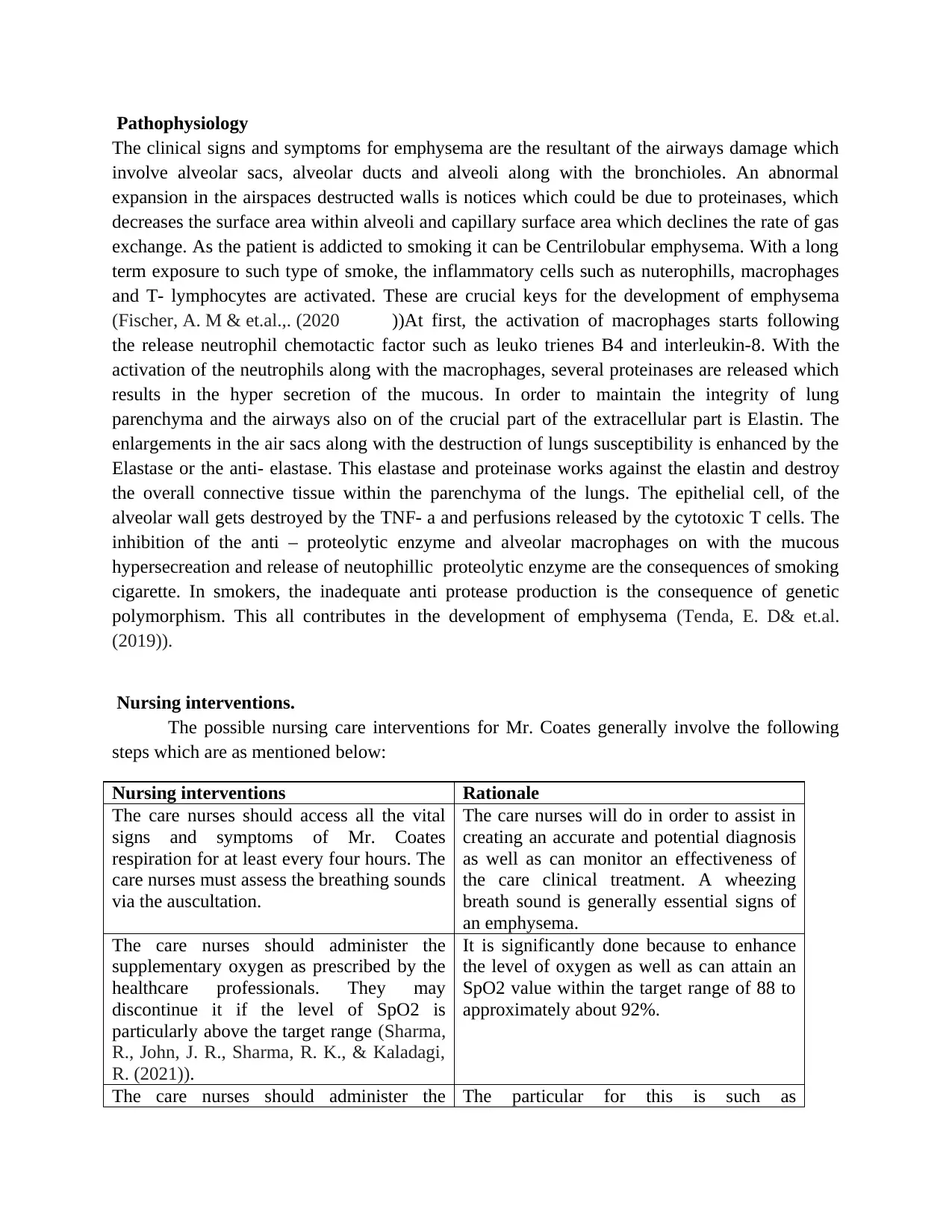
Pathophysiology
The clinical signs and symptoms for emphysema are the resultant of the airways damage which
involve alveolar sacs, alveolar ducts and alveoli along with the bronchioles. An abnormal
expansion in the airspaces destructed walls is notices which could be due to proteinases, which
decreases the surface area within alveoli and capillary surface area which declines the rate of gas
exchange. As the patient is addicted to smoking it can be Centrilobular emphysema. With a long
term exposure to such type of smoke, the inflammatory cells such as nuterophills, macrophages
and T- lymphocytes are activated. These are crucial keys for the development of emphysema
(Fischer, A. M & et.al.,. (2020 ))At first, the activation of macrophages starts following
the release neutrophil chemotactic factor such as leuko trienes B4 and interleukin-8. With the
activation of the neutrophils along with the macrophages, several proteinases are released which
results in the hyper secretion of the mucous. In order to maintain the integrity of lung
parenchyma and the airways also on of the crucial part of the extracellular part is Elastin. The
enlargements in the air sacs along with the destruction of lungs susceptibility is enhanced by the
Elastase or the anti- elastase. This elastase and proteinase works against the elastin and destroy
the overall connective tissue within the parenchyma of the lungs. The epithelial cell, of the
alveolar wall gets destroyed by the TNF- a and perfusions released by the cytotoxic T cells. The
inhibition of the anti – proteolytic enzyme and alveolar macrophages on with the mucous
hypersecreation and release of neutophillic proteolytic enzyme are the consequences of smoking
cigarette. In smokers, the inadequate anti protease production is the consequence of genetic
polymorphism. This all contributes in the development of emphysema (Tenda, E. D& et.al.
(2019)).
Nursing interventions.
The possible nursing care interventions for Mr. Coates generally involve the following
steps which are as mentioned below:
Nursing interventions Rationale
The care nurses should access all the vital
signs and symptoms of Mr. Coates
respiration for at least every four hours. The
care nurses must assess the breathing sounds
via the auscultation.
The care nurses will do in order to assist in
creating an accurate and potential diagnosis
as well as can monitor an effectiveness of
the care clinical treatment. A wheezing
breath sound is generally essential signs of
an emphysema.
The care nurses should administer the
supplementary oxygen as prescribed by the
healthcare professionals. They may
discontinue it if the level of SpO2 is
particularly above the target range (Sharma,
R., John, J. R., Sharma, R. K., & Kaladagi,
R. (2021)).
It is significantly done because to enhance
the level of oxygen as well as can attain an
SpO2 value within the target range of 88 to
approximately about 92%.
The care nurses should administer the The particular for this is such as
The clinical signs and symptoms for emphysema are the resultant of the airways damage which
involve alveolar sacs, alveolar ducts and alveoli along with the bronchioles. An abnormal
expansion in the airspaces destructed walls is notices which could be due to proteinases, which
decreases the surface area within alveoli and capillary surface area which declines the rate of gas
exchange. As the patient is addicted to smoking it can be Centrilobular emphysema. With a long
term exposure to such type of smoke, the inflammatory cells such as nuterophills, macrophages
and T- lymphocytes are activated. These are crucial keys for the development of emphysema
(Fischer, A. M & et.al.,. (2020 ))At first, the activation of macrophages starts following
the release neutrophil chemotactic factor such as leuko trienes B4 and interleukin-8. With the
activation of the neutrophils along with the macrophages, several proteinases are released which
results in the hyper secretion of the mucous. In order to maintain the integrity of lung
parenchyma and the airways also on of the crucial part of the extracellular part is Elastin. The
enlargements in the air sacs along with the destruction of lungs susceptibility is enhanced by the
Elastase or the anti- elastase. This elastase and proteinase works against the elastin and destroy
the overall connective tissue within the parenchyma of the lungs. The epithelial cell, of the
alveolar wall gets destroyed by the TNF- a and perfusions released by the cytotoxic T cells. The
inhibition of the anti – proteolytic enzyme and alveolar macrophages on with the mucous
hypersecreation and release of neutophillic proteolytic enzyme are the consequences of smoking
cigarette. In smokers, the inadequate anti protease production is the consequence of genetic
polymorphism. This all contributes in the development of emphysema (Tenda, E. D& et.al.
(2019)).
Nursing interventions.
The possible nursing care interventions for Mr. Coates generally involve the following
steps which are as mentioned below:
Nursing interventions Rationale
The care nurses should access all the vital
signs and symptoms of Mr. Coates
respiration for at least every four hours. The
care nurses must assess the breathing sounds
via the auscultation.
The care nurses will do in order to assist in
creating an accurate and potential diagnosis
as well as can monitor an effectiveness of
the care clinical treatment. A wheezing
breath sound is generally essential signs of
an emphysema.
The care nurses should administer the
supplementary oxygen as prescribed by the
healthcare professionals. They may
discontinue it if the level of SpO2 is
particularly above the target range (Sharma,
R., John, J. R., Sharma, R. K., & Kaladagi,
R. (2021)).
It is significantly done because to enhance
the level of oxygen as well as can attain an
SpO2 value within the target range of 88 to
approximately about 92%.
The care nurses should administer the The particular for this is such as
Secure Best Marks with AI Grader
Need help grading? Try our AI Grader for instant feedback on your assignments.
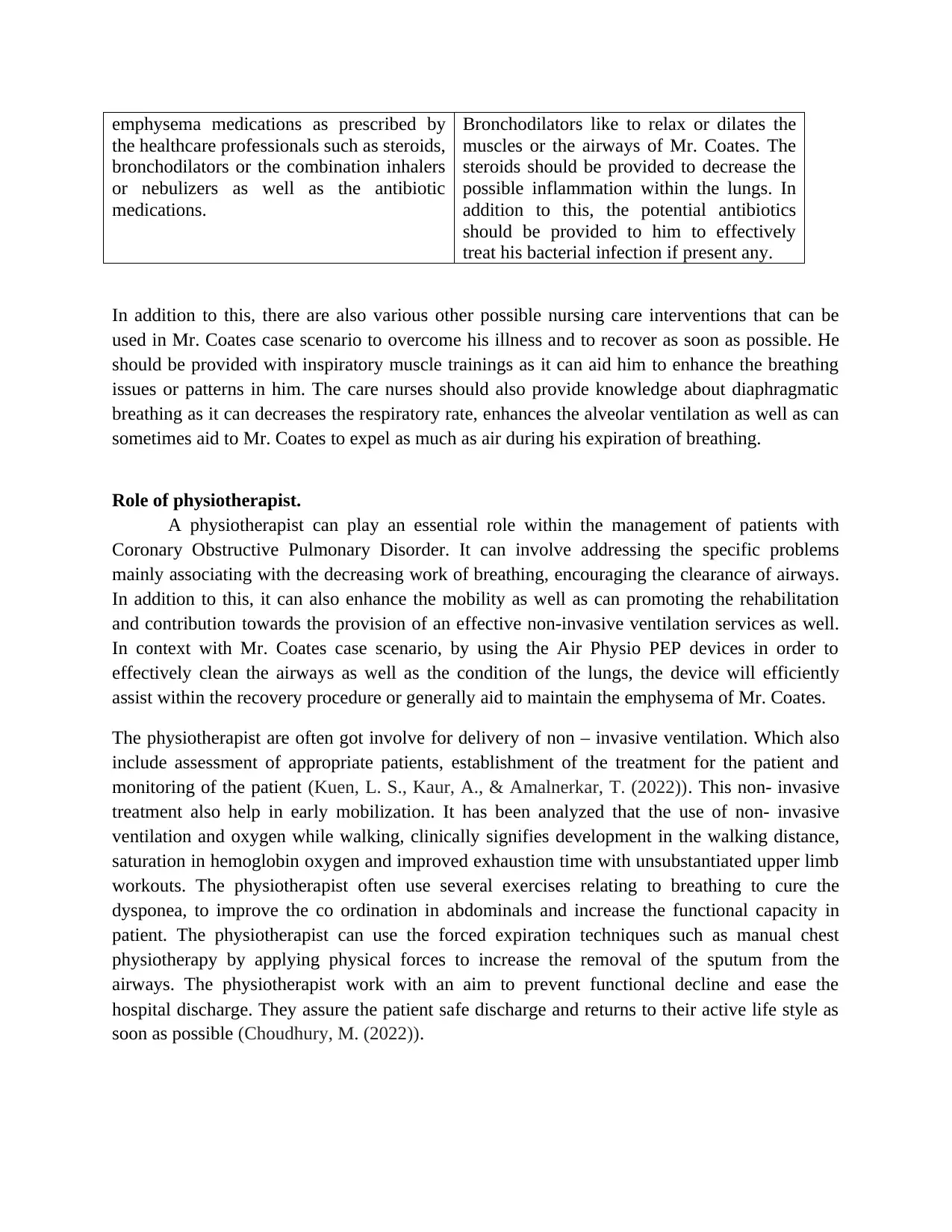
emphysema medications as prescribed by
the healthcare professionals such as steroids,
bronchodilators or the combination inhalers
or nebulizers as well as the antibiotic
medications.
Bronchodilators like to relax or dilates the
muscles or the airways of Mr. Coates. The
steroids should be provided to decrease the
possible inflammation within the lungs. In
addition to this, the potential antibiotics
should be provided to him to effectively
treat his bacterial infection if present any.
In addition to this, there are also various other possible nursing care interventions that can be
used in Mr. Coates case scenario to overcome his illness and to recover as soon as possible. He
should be provided with inspiratory muscle trainings as it can aid him to enhance the breathing
issues or patterns in him. The care nurses should also provide knowledge about diaphragmatic
breathing as it can decreases the respiratory rate, enhances the alveolar ventilation as well as can
sometimes aid to Mr. Coates to expel as much as air during his expiration of breathing.
Role of physiotherapist.
A physiotherapist can play an essential role within the management of patients with
Coronary Obstructive Pulmonary Disorder. It can involve addressing the specific problems
mainly associating with the decreasing work of breathing, encouraging the clearance of airways.
In addition to this, it can also enhance the mobility as well as can promoting the rehabilitation
and contribution towards the provision of an effective non-invasive ventilation services as well.
In context with Mr. Coates case scenario, by using the Air Physio PEP devices in order to
effectively clean the airways as well as the condition of the lungs, the device will efficiently
assist within the recovery procedure or generally aid to maintain the emphysema of Mr. Coates.
The physiotherapist are often got involve for delivery of non – invasive ventilation. Which also
include assessment of appropriate patients, establishment of the treatment for the patient and
monitoring of the patient (Kuen, L. S., Kaur, A., & Amalnerkar, T. (2022)). This non- invasive
treatment also help in early mobilization. It has been analyzed that the use of non- invasive
ventilation and oxygen while walking, clinically signifies development in the walking distance,
saturation in hemoglobin oxygen and improved exhaustion time with unsubstantiated upper limb
workouts. The physiotherapist often use several exercises relating to breathing to cure the
dysponea, to improve the co ordination in abdominals and increase the functional capacity in
patient. The physiotherapist can use the forced expiration techniques such as manual chest
physiotherapy by applying physical forces to increase the removal of the sputum from the
airways. The physiotherapist work with an aim to prevent functional decline and ease the
hospital discharge. They assure the patient safe discharge and returns to their active life style as
soon as possible (Choudhury, M. (2022)).
the healthcare professionals such as steroids,
bronchodilators or the combination inhalers
or nebulizers as well as the antibiotic
medications.
Bronchodilators like to relax or dilates the
muscles or the airways of Mr. Coates. The
steroids should be provided to decrease the
possible inflammation within the lungs. In
addition to this, the potential antibiotics
should be provided to him to effectively
treat his bacterial infection if present any.
In addition to this, there are also various other possible nursing care interventions that can be
used in Mr. Coates case scenario to overcome his illness and to recover as soon as possible. He
should be provided with inspiratory muscle trainings as it can aid him to enhance the breathing
issues or patterns in him. The care nurses should also provide knowledge about diaphragmatic
breathing as it can decreases the respiratory rate, enhances the alveolar ventilation as well as can
sometimes aid to Mr. Coates to expel as much as air during his expiration of breathing.
Role of physiotherapist.
A physiotherapist can play an essential role within the management of patients with
Coronary Obstructive Pulmonary Disorder. It can involve addressing the specific problems
mainly associating with the decreasing work of breathing, encouraging the clearance of airways.
In addition to this, it can also enhance the mobility as well as can promoting the rehabilitation
and contribution towards the provision of an effective non-invasive ventilation services as well.
In context with Mr. Coates case scenario, by using the Air Physio PEP devices in order to
effectively clean the airways as well as the condition of the lungs, the device will efficiently
assist within the recovery procedure or generally aid to maintain the emphysema of Mr. Coates.
The physiotherapist are often got involve for delivery of non – invasive ventilation. Which also
include assessment of appropriate patients, establishment of the treatment for the patient and
monitoring of the patient (Kuen, L. S., Kaur, A., & Amalnerkar, T. (2022)). This non- invasive
treatment also help in early mobilization. It has been analyzed that the use of non- invasive
ventilation and oxygen while walking, clinically signifies development in the walking distance,
saturation in hemoglobin oxygen and improved exhaustion time with unsubstantiated upper limb
workouts. The physiotherapist often use several exercises relating to breathing to cure the
dysponea, to improve the co ordination in abdominals and increase the functional capacity in
patient. The physiotherapist can use the forced expiration techniques such as manual chest
physiotherapy by applying physical forces to increase the removal of the sputum from the
airways. The physiotherapist work with an aim to prevent functional decline and ease the
hospital discharge. They assure the patient safe discharge and returns to their active life style as
soon as possible (Choudhury, M. (2022)).
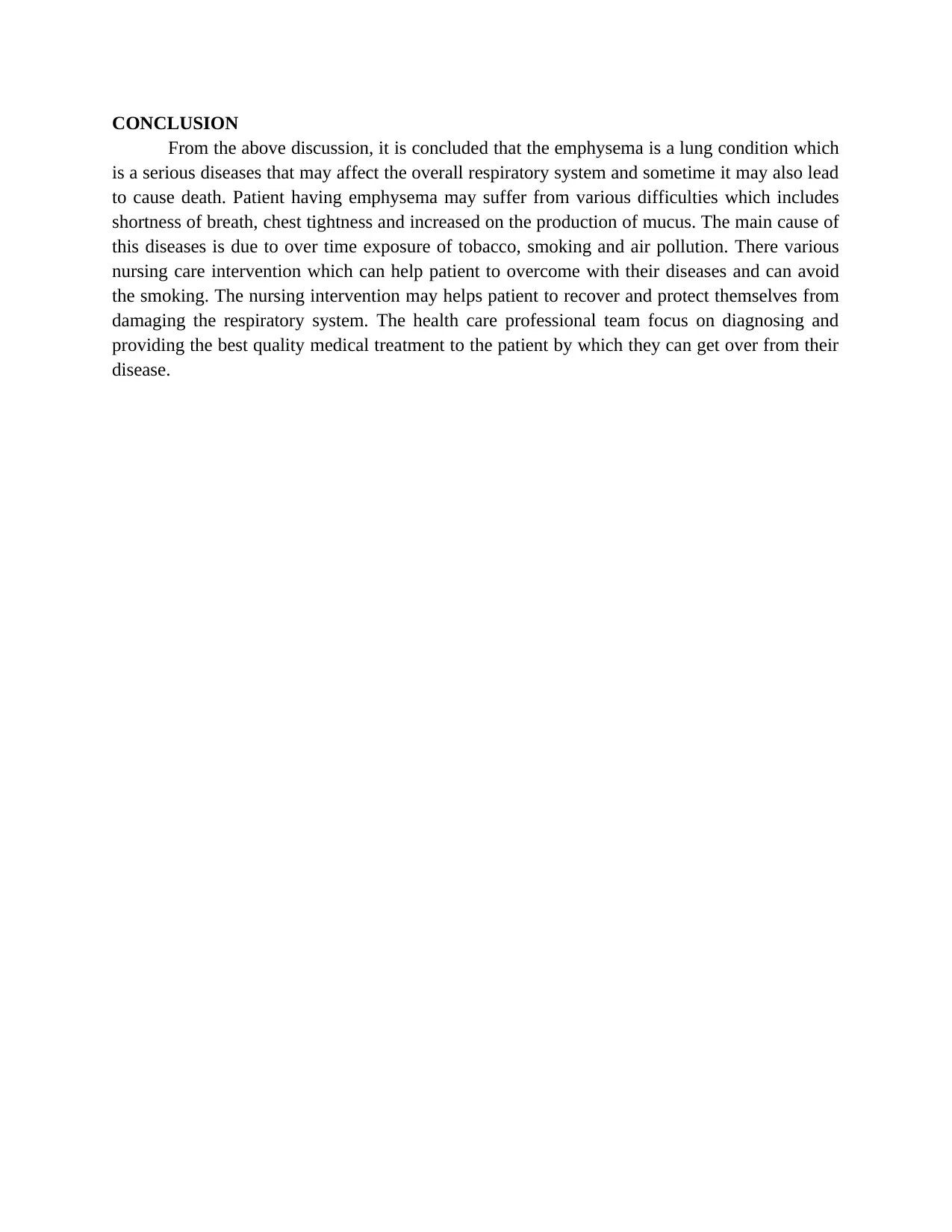
CONCLUSION
From the above discussion, it is concluded that the emphysema is a lung condition which
is a serious diseases that may affect the overall respiratory system and sometime it may also lead
to cause death. Patient having emphysema may suffer from various difficulties which includes
shortness of breath, chest tightness and increased on the production of mucus. The main cause of
this diseases is due to over time exposure of tobacco, smoking and air pollution. There various
nursing care intervention which can help patient to overcome with their diseases and can avoid
the smoking. The nursing intervention may helps patient to recover and protect themselves from
damaging the respiratory system. The health care professional team focus on diagnosing and
providing the best quality medical treatment to the patient by which they can get over from their
disease.
From the above discussion, it is concluded that the emphysema is a lung condition which
is a serious diseases that may affect the overall respiratory system and sometime it may also lead
to cause death. Patient having emphysema may suffer from various difficulties which includes
shortness of breath, chest tightness and increased on the production of mucus. The main cause of
this diseases is due to over time exposure of tobacco, smoking and air pollution. There various
nursing care intervention which can help patient to overcome with their diseases and can avoid
the smoking. The nursing intervention may helps patient to recover and protect themselves from
damaging the respiratory system. The health care professional team focus on diagnosing and
providing the best quality medical treatment to the patient by which they can get over from their
disease.
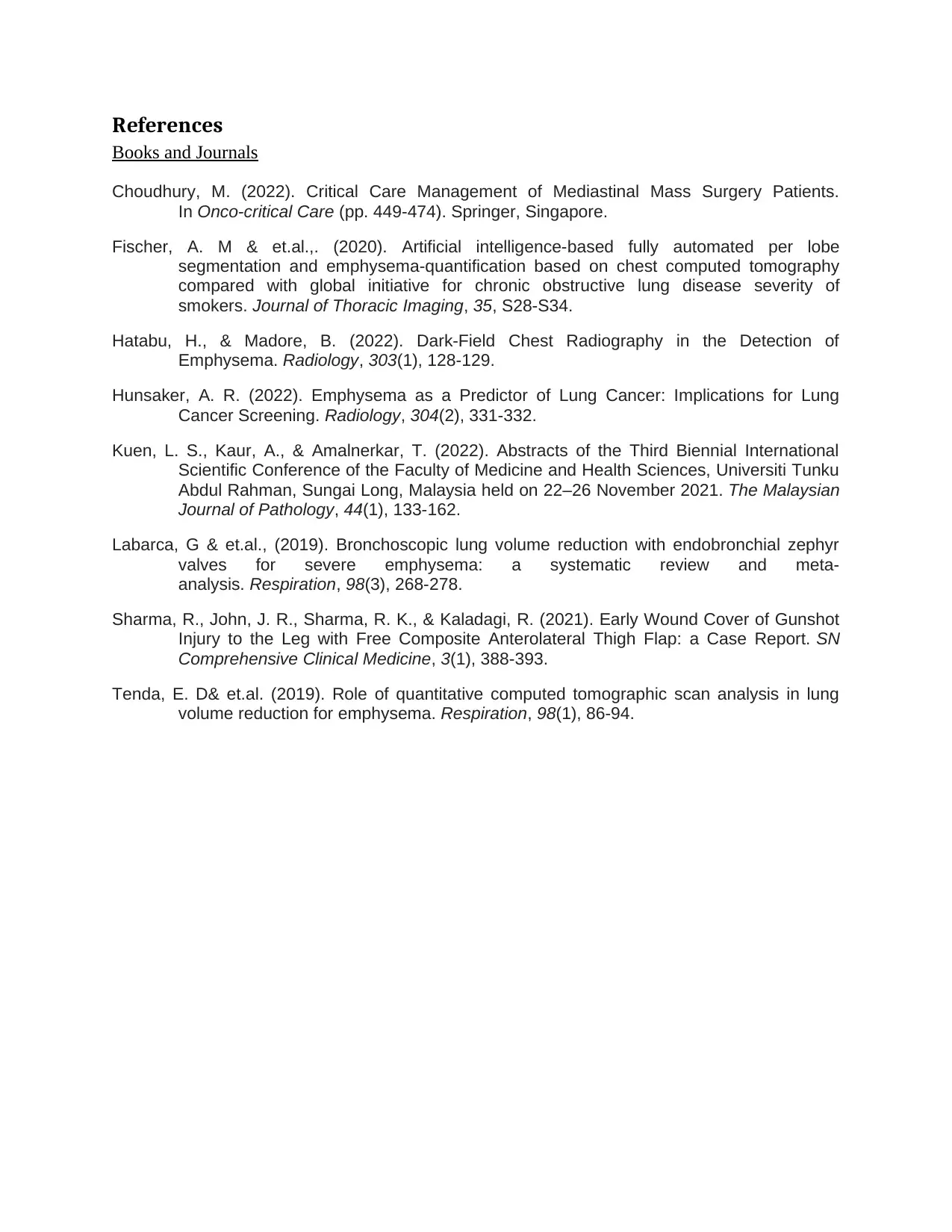
References
Books and Journals
Choudhury, M. (2022). Critical Care Management of Mediastinal Mass Surgery Patients.
In Onco-critical Care (pp. 449-474). Springer, Singapore.
Fischer, A. M & et.al.,. (2020). Artificial intelligence-based fully automated per lobe
segmentation and emphysema-quantification based on chest computed tomography
compared with global initiative for chronic obstructive lung disease severity of
smokers. Journal of Thoracic Imaging, 35, S28-S34.
Hatabu, H., & Madore, B. (2022). Dark-Field Chest Radiography in the Detection of
Emphysema. Radiology, 303(1), 128-129.
Hunsaker, A. R. (2022). Emphysema as a Predictor of Lung Cancer: Implications for Lung
Cancer Screening. Radiology, 304(2), 331-332.
Kuen, L. S., Kaur, A., & Amalnerkar, T. (2022). Abstracts of the Third Biennial International
Scientific Conference of the Faculty of Medicine and Health Sciences, Universiti Tunku
Abdul Rahman, Sungai Long, Malaysia held on 22–26 November 2021. The Malaysian
Journal of Pathology, 44(1), 133-162.
Labarca, G & et.al., (2019). Bronchoscopic lung volume reduction with endobronchial zephyr
valves for severe emphysema: a systematic review and meta-
analysis. Respiration, 98(3), 268-278.
Sharma, R., John, J. R., Sharma, R. K., & Kaladagi, R. (2021). Early Wound Cover of Gunshot
Injury to the Leg with Free Composite Anterolateral Thigh Flap: a Case Report. SN
Comprehensive Clinical Medicine, 3(1), 388-393.
Tenda, E. D& et.al. (2019). Role of quantitative computed tomographic scan analysis in lung
volume reduction for emphysema. Respiration, 98(1), 86-94.
Books and Journals
Choudhury, M. (2022). Critical Care Management of Mediastinal Mass Surgery Patients.
In Onco-critical Care (pp. 449-474). Springer, Singapore.
Fischer, A. M & et.al.,. (2020). Artificial intelligence-based fully automated per lobe
segmentation and emphysema-quantification based on chest computed tomography
compared with global initiative for chronic obstructive lung disease severity of
smokers. Journal of Thoracic Imaging, 35, S28-S34.
Hatabu, H., & Madore, B. (2022). Dark-Field Chest Radiography in the Detection of
Emphysema. Radiology, 303(1), 128-129.
Hunsaker, A. R. (2022). Emphysema as a Predictor of Lung Cancer: Implications for Lung
Cancer Screening. Radiology, 304(2), 331-332.
Kuen, L. S., Kaur, A., & Amalnerkar, T. (2022). Abstracts of the Third Biennial International
Scientific Conference of the Faculty of Medicine and Health Sciences, Universiti Tunku
Abdul Rahman, Sungai Long, Malaysia held on 22–26 November 2021. The Malaysian
Journal of Pathology, 44(1), 133-162.
Labarca, G & et.al., (2019). Bronchoscopic lung volume reduction with endobronchial zephyr
valves for severe emphysema: a systematic review and meta-
analysis. Respiration, 98(3), 268-278.
Sharma, R., John, J. R., Sharma, R. K., & Kaladagi, R. (2021). Early Wound Cover of Gunshot
Injury to the Leg with Free Composite Anterolateral Thigh Flap: a Case Report. SN
Comprehensive Clinical Medicine, 3(1), 388-393.
Tenda, E. D& et.al. (2019). Role of quantitative computed tomographic scan analysis in lung
volume reduction for emphysema. Respiration, 98(1), 86-94.
1 out of 7
Related Documents
Your All-in-One AI-Powered Toolkit for Academic Success.
+13062052269
info@desklib.com
Available 24*7 on WhatsApp / Email
![[object Object]](/_next/static/media/star-bottom.7253800d.svg)
Unlock your academic potential
© 2024 | Zucol Services PVT LTD | All rights reserved.





